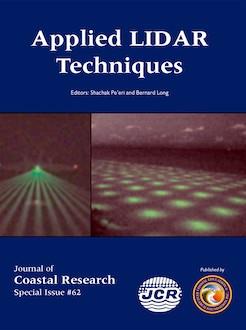Airborne light detection and ranging (LIDAR) bathymetry (ALB) is an efficient remote-sensing technique for shallow-water mapping using green-channel waveforms. In addition to the green-channel waveforms, the SHOALS-3000 ALB system collects laser measurements in the red and infrared channels. The goal of this study was to evaluate the capacity of the ALB system to discriminate between land and water using all available channels in the system. This paper provides a review of all currently available ALB-based land-water interface algorithms (green-, red-, and infrared-channel waveforms) and a quantitative evaluation of the algorithms' performance on the basis of both individual laser measurement products and the resulting shoreline vector feature. Data for this study were collected with the use of a SHOALS-3000 system over five study sites along the New Hampshire and Maine coastlines that contain rocks, vegetation, and man-made features. All ALB shoreline algorithms show successful results in discriminating between land and water, but the best-performing algorithm only contains information from the infrared (IR)-channel waveforms (IR saturation algorithm) and the worst-performing algorithms only contain information from the red-channel waveforms (red standard deviation algorithm). The main environmental parameters that affect the performances of the algorithms are the vegetation in the rocky shoreline and the presence of surf along the sandy shoreline.
BioOne.org will be down briefly for maintenance on 17 December 2024 between 18:00-22:00 Pacific Time US. We apologize for any inconvenience.
How to translate text using browser tools
1 March 2011
Land-Water Interface Resolved from Airborne LIDAR Bathymetry (ALB) Waveforms
Shachak Pe'eri,
Lynnette V. Morgan,
William D. Philpot,
Andrew A. Armstrong
ACCESS THE FULL ARTICLE
airborne LIDAR bathymetry (ALB)
Shoreline
waveforms





